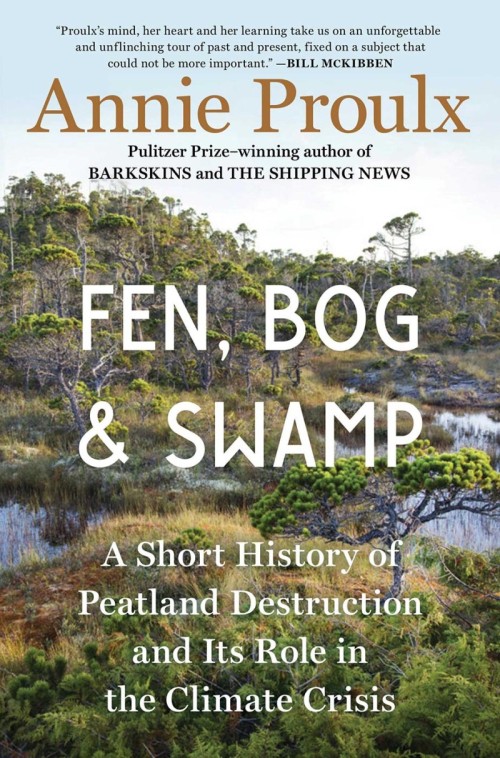by Annie Proulx
Scribner 2022
The best writers, whether they focus on fiction or truth, are first and foremost storytellers. Pulitzer Prize winner Annie Proulx is among the best. In her slim volume, Fen, Bog & Swamp: A Short History of Peatland Destruction and Its Role in the Climate Crisis, Proulx employs stories as she shares the innumerable facts she’s garnered on this topic.
Proulx describes how, when she was a little girl, her mother “…led me through a blueberry thicket to a sudden swamp where she jumped from dry land to a grass tussock, then to another, and I tried to follow. I made it to a quivering clump and looked down into the water.” Fear held her back, and her mother carried her to firm ground. For Proulx, the experience “was frightening and exciting,” and that memory remains vivid many decades later.
In writing Fen, Bog & Swamp, Proulx set out “to understand the wetlands that are so intimately tied to the climate crisis.” In doing so, she dug into mounds of information – much of it contained in scientific reports replete with specialized vocabularies. She’s not a scientist, so her labor involved translating some terms, and she wrote, “I suspect this gulf of esoteric language is an important part of the disconnection between science and ordinary readers.”
As the title indicates, Proulx focuses on three wetland types, all of them “peatlands,” still water bodies where dead plants and other detritus decompose slowly, and therefore keep carbon out of the atmosphere. As Proulx explains, the source and depth of the water determines whether a wetland is a fen, bog, or swamp. Fens tend to be deep, and at least some of the water that feeds them is from streams or rivers. Bogs, which are generally shallower than fens, are fed by rain; the water does not come in contact with mineral soil. Swamps are shallower still, which allows shrubs and trees to grow. When these wetlands are destroyed, the process releases carbon dioxide and methane into the atmosphere.
The book is littered with facts and is liberally laced with Proulx’s anger and dismay about how people worldwide have devastated wetlands that provide important habitat for many organisms and are critical to many ecosystems. This destruction has accelerated during the past few centuries. Proulx describes a 300-year failed struggle to save the conversion of England’s fen region. She also notes that by the 1980s, 50 percent of the United States’ wetlands were gone.
“Improvements” to the Great Dismal Swamp, for example, commenced in the 1760s when several investors, including George Washington, established the Dismal Swamp Company to drain the swamp; extract white cedar, tupelo, and cypress; and create farmland. In the 1970s, the Union Camp Company, which owned the Great Dismal Swamp at the time, donated 50,000 acres to The Nature Conservancy. Eventually, the Conservancy gave the property to the federal government. Today it is the Great Dismal Swamp National Wildlife Refuge. Although the refuge is a conservation success story, it’s also a reminder of how much was lost. In the 1700s, the swamp covered more than 2,000 square miles. Today it is about 175 square miles, including the magnificent Lake Drummond.
Proulx’s elegant prose flows from fen, to bog, to swamp. This is an informative and important work. But it’s not an easy or pleasant read; it’s discouraging to realize that many people do not understand, or perhaps care, what occurs when a wetland is eviscerated.


